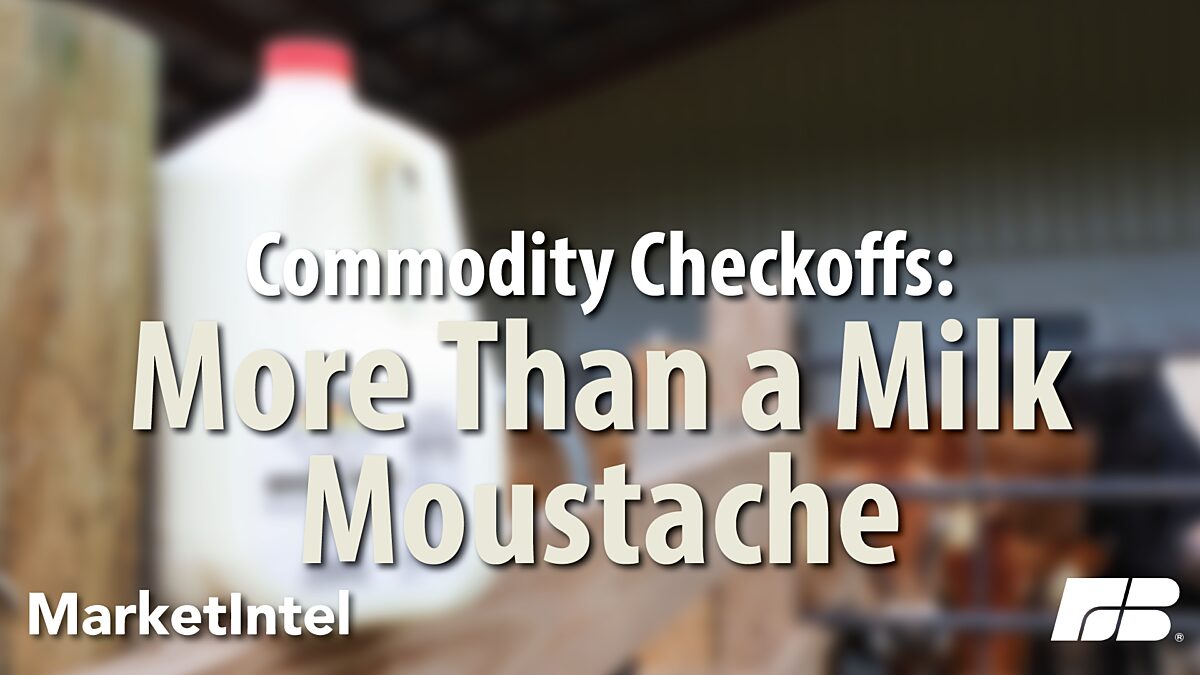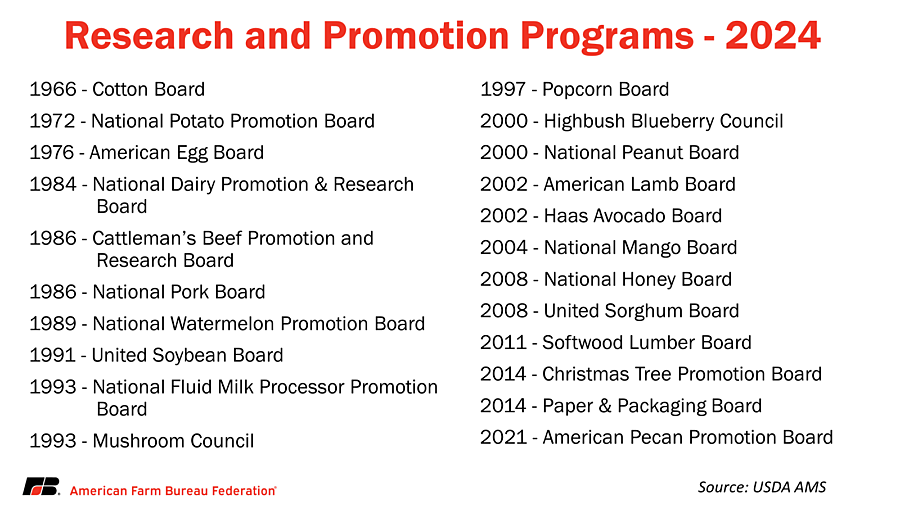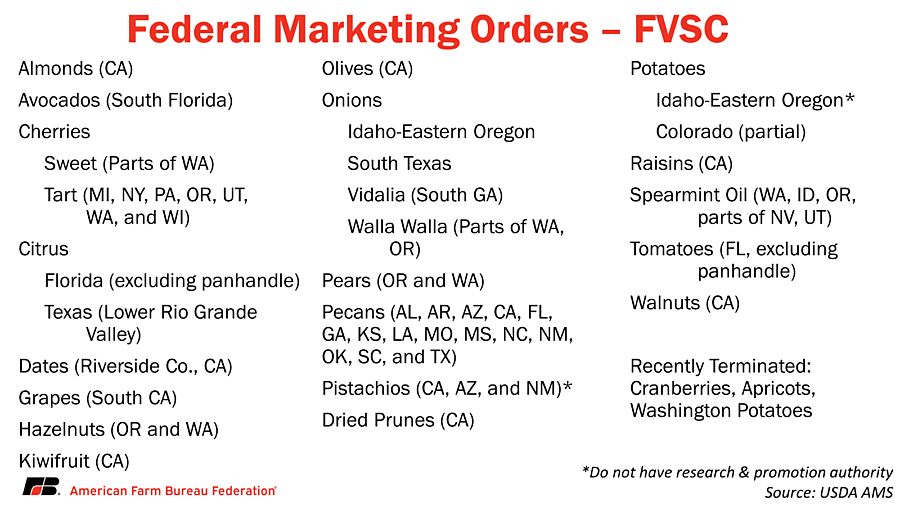Commodity Checkoffs: More Than a Milk Moustache

Bernt Nelson
Economist
Betty Resnick
Economist
National advertising campaigns asking if you’ve “Got Milk?” or telling you “Beef. It’s What’s for Dinner” generated a lot of buzz – and sales of dairy and beef, respectively. Though they may be some of the most recognized initiatives from industry checkoffs, the work of these programs representing agricultural products ranging from dairy and beef to peanuts, popcorn, paper and Christmas trees have been a catalyst for innovation across numerous commodities. In this Market Intel, we’ll explore the history of checkoffs and their role in promoting agriculture.
Research and Promotion Programs
The best-known checkoff programs are research and promotion (R&P) programs, run by R&P boards with a mission to maintain and expand markets for a specific commodity. Originally, these programs existed on a voluntary basis; farmers and ranchers had the option to check a box when they sold a product that gave part of their revenue to research and promotion of the commodity, hence the term “checkoff.” As these programs grew, a classic free-rider problem developed as farmers and ranchers who did not contribute to checkoffs were still receiving all the benefits to the industry that checkoffs provided. Federal R&P programs became a solution to this issue. Today, there are 22 active R&P programs.
Of the 22 active R&P programs, 10 are authorized under the Commodity Promotion, Research, and Information Act of 1996. The other programs are authorized under commodity-specific federal legislation. The oldest federal R&P program is the Cotton Board, which was established in 1966 to reestablish markets for cotton as synthetic fabrics were beginning to replace cotton fabric. Today, all producers of cotton are assessed at $1 per bale and 0.5% of the value of the cotton bale. Cotton importers are also assessed a comparable amount based on the weight of cotton or cotton products imported. In addition to promotion efforts such as The Seal of Cotton™, a logo that has been around since 1973 and is one of the most recognized logos in the country, the Cotton Board has sponsored pioneering research that led to the cotton module builder, which builds the large compact bales you’ll see in cotton country at harvest. The Cotton Board also supported research that has made cottonseed a popular and effective feed for cattle. With this research, cottonseed has gone from an unwanted byproduct to an increasingly important part of the crop’s value.
R&P Program Rules
R&P programs are self-funded by the industry. USDA’s Agricultural Marketing Service provides oversight for the programs to ensure fiscal accountability and program integrity. The programs reimburse AMS for the oversight through industry assessments, so no taxpayer dollars are used to fund the oversight of R&P programs. All R&P programs are required to exempt organic products from assessment requirements. Additionally, a majority of R&P programs provide assessment exemptions to small producers and small importers[BR1][EM2] , the definition of which is different for each commodity program.
All R&P programs carry out their mission to maintain and expand markets for their specific commodity through research and development, domestic and international promotion, and consumer and industry education. They are explicitly banned from using assessment or “checkoff” funding for lobbying or to promote specific brands. Instead, the R&P programs must focus on promoting the sector as a whole, including imports, if importers are also assessed.
For example, the U.S. Highbush Blueberry Council (USHBC) does not promote exclusively U.S.-grown blueberries as an assessment is also placed on imported blueberries. Instead, USHBC promotes blueberries broadly with the goal of making them the most consumed berry worldwide. Since the council’s inception in 2000, domestic blueberry consumption and production have skyrocketed. Between 2000-2002 and 2018-2020, average per capita blueberry consumption grew to 2.2 pounds per person – an increase of 574%. The increase in consumption is fueled by both an increase in domestic production (+283% to 343 million pounds) and an increase in imports (+919% to 450 million pounds).
All R&P programs undergo independent annual audits, and are subject to referendum, though the referendum rules vary by commodity. Referendums take place to establish a new R&P program and to affirm continuation of existing R&P programs. All R&P programs authorized under the Commodity Promotion, Research, and Information Act of 1996 are required to hold a referendum every five years. Others, authorized under previous legislation, are subject to their own rules for referendum.
The most recent referendum was held for the National Peanut Board in April 2024, and passed with 93% of peanut producers voting to continue the program.
The United Soybean Board requires AMS to conduct a request for referendum every five years and recently conducted a request for referendum between May 6 and May 31. For a referendum to be requested, 10% of all soybean growers (41,336 in total) would need to return a completed form to their county Farm Service Agency office by May 31. No more than 20% of total petitions may be from the same state. While results of the 2024 request for referendum are not yet public, when it was last held in 2019, only 703 total requests were received, representing only 0.13% of all eligible soybean farmers.
The Beef Promotion and Research Order, established by the 1985 farm bill and approved by national referendum vote in 1988, authorizes the Cattlemen’s Beef Promotion and Research Board. The program requires a referendum only if a representative group comprising 10% or more of total cattle producers signs a petition for referendum within a 12-month period. A petition for referendum was launched on July 2, 2020, and ultimately failed to validate the 88,269 signatures required at the time. According to the 2022 Census of Agriculture, there were 732,123 farms producing cattle at the time of the census, so future petitions would require at least 73,212 signatures to conduct a referendum.
How is Money Spent?
Money from R&P programs can be used in a variety of ways. Typically, it is spent on research, promotion or education to build demand and expand markets for each respective commodity. For example, the purpose of the Cattlemen’s Beef Board is to “stimulate beef sales and consumption through a combination of initiatives including consumer advertising, research, public relations and new-product development.” Traditionally, these programs used advertising as one of the pillars of programming, but as the cost of advertising has increased, spending has moved toward scientific research and education.
R&P programs use money for various aspects of research by funding projects and publishing their results. Some of these projects are done through universities or Extension in the land-grant university system. Others may be done in collaboration with industry partners. One example of R&P research is that conducted by the National Dairy Promotion and Research board, more commonly known as the “Dairy Checkoff.” The Dairy Checkoff conducted scientific research that has led to the reevaluation of the nutritional benefits of animal fats. The results of this research are then used to educate the public and stimulate demand for nutritional dairy products such as milk and cheese. In another example, the National Peanut Board invested research on addressing peanut allergies.
Checkoffs promote products both at home and abroad. The U.S. Meat Export Federation is a trade association largely funded by a coalition of checkoffs including those for the pork, beef, lamb, soybean and corn industries. USMEF has offices throughout the world to boost exports of U.S. red meat by connecting buyers and sellers, working on market access for U.S. products, and marketing in foreign markets. A variety of tactics are used for in-country promotion: from helping a Korean food chain transition to using 100% U.S. beef, to creating culturally relevant recipes for underutilized cuts of meat, to teaming up with local food influencers to educate the public on cooking techniques to maximize pork flavor.
Federal Marketing Orders
Federal marketing orders were established under the Agricultural Marketing Agreement Act of 1937 to establish minimum standards of quality, maintain grading and inspection requirements and, in rare instances, manage supply. Many federal marketing orders, including nearly all the orders regulating the marketing of fruits, vegetables and other specialty crops, also have research and promotion functions like the R&P-only programs. Both take the form of orders that must be voted for by producers and both are administered by USDA, funded by a per-unit fee imposed when the product covered by the order is sold, and can be considered “self-help” programs for the industry. They must be initially approved by a majority of producers of a specific commodity and re-approved every five years through a referendum. The only two federal marketing orders for specialty crops without a research and promotion component are potatoes and pistachios, which both focus on quality regulation.
Marketing orders are binding regulations for an entire industry in a specific geographic region. There are currently 25 federal marketing orders for fruits, vegetables and specialty crops (FVSC).
Voting
R&P programs and federal marketing orders are both subject to referendum, through which farmers and program members can influence what checkoff dollars get used. However, voting can be conducted differently for different R&P programs and federal marketing orders.
Dairy, for example, is an industry with a high rate of cooperative membership. The Dairy Checkoff uses a system called modified bloc voting. Under this system, when changes are proposed, a cooperative may bloc vote on behalf of its members. If it does, it must notify its members that the cooperative intends to cast a bloc vote ballot. If any producer wishes to cast a ballot individually, the cooperative must inform the producer of procedures to cast an individual and confidential ballot. The cooperative may then vote on behalf of all members who have not opted to cast an individual ballot. This allows freedom for individual producers to have their vote counted and their voice heard, but respects many farmers’ decision to make marketing decisions through their cooperative association.
State Checkoffs and Marketing Orders
Several states maintain similar programs, often referred to as commodity boards or commissions. State programs layer assessments on top of those established by federal entities and provide more localized research and marketing. For instance, state checkoffs can better focus research on pests or climate particular to a single state. For some products that predominantly grow in only one state, like table grapes, a state commission is the main checkoff program for that commodity. In this instance, the California Table Grape Commission maintains and expands markets for fresh California grapes both domestically and abroad. Often state-level programs also have a focus on data collection.
Summary and Conclusions
R&P programs and the research and promotion elements of federal marketing orders, commonly known as “checkoff” programs, operate by taking a small assessment from the sale of each unit of a given commodity to fund research and promotion of the commodity as a whole. AMS oversees the programs for accountability and integrity.
Legally, messages delivered by R&P entities are protected government speech and not all stakeholders may agree with the messages these programs deliver, or even the fact that they exist. The members of the boards that run these programs are not elected; although they must be nominated by producer (or importer) organizations, they are chosen by the secretary of agriculture. Farmers can only have direct democratic influence by voting to create, continue or terminate a research and promotion program or a marketing order, or to approve or disapprove changes in assessment rates. Despite some controversy, most checkoffs have overwhelming support from commodity producers and continue to support a variety of research and promotion efforts that help maintain and expand both domestic and global markets for the livestock and crops our country’s farmers produce.

